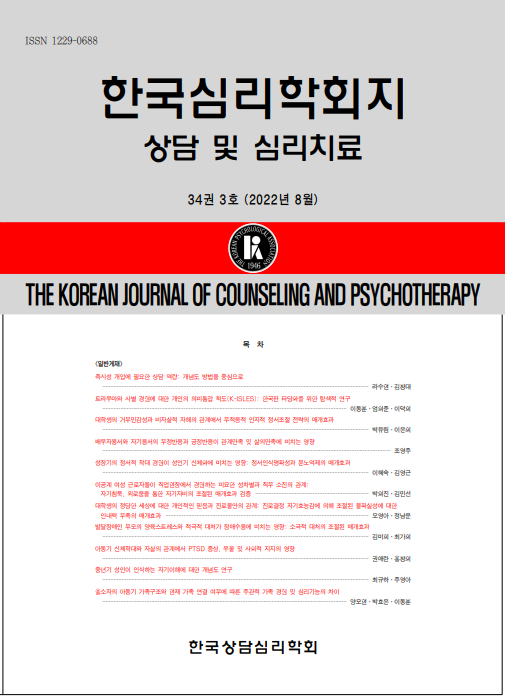open access
메뉴
open access
메뉴 ISSN : 1229-0688
ISSN : 1229-0688
본 연구는 세월호 재난 이후 5년이 지난 시점에서 유가족의 낙인경험을 탐색하고자 수행되었다. 세월호 재난 이후 5년 시점에서 유가족의 경험을 탐색한 연구의 구술자료가 활용되었으며, 연구참여자는 유가족협의회에 소속된 부모 15명이었다. 면담자료는 Corrigan과 Kosyluk (2014)의 낙인사회인지모델의 관점에서 Braun과 Clarke(2012)가 제안한 주제분석 절차를 활용하여 분석되었다. 세월호 유가족의 낙인경험을 사회적 낙인과 자기 낙인으로 분류한 후, 각각 고정관념, 편견, 차별로 세분화하였다. 사회적 낙인에서의 고정관념은 세월호 유가족은 ‘함께하기에 불편한 존재’, ‘보상과 혜택을 받은 사람’ 등 6가지 범주, 편견은 세월호 유가족은 ‘부담스럽고 불편함’, ‘시샘이 남’ 등 6가지 범주, 차별은 세월호 유가족에게 ‘비난을 숨기지 않음’, ‘무관심해짐’ 등 5가지 범주로 도출되었다. 자기 낙인에서의 고정관념은 ‘나는 자식을 지키지 못한 죄인’ 등 3가지 범주, 편견은 ‘죄책감’, ‘두려움’ 2가지 범주, 차별은 ‘사회적 관계에서 철수함’ 등 3가지 범주로 도출되었다. 또한 연구결과, 연구참여자들은 스스로 낙인에 대한 보호요인을 가지고 있는 것으로 나타났는데, 이는 ‘뜻이 맞는 세월호 유가족과 함께하며 소속감을 느낌’ 등 5가지 범주로 도출되었다. 본 연구결과를 바탕으로 논의와 시사점을 제시하였다.
The current study explored the experiences of stigma in the bereaved families of the victims of the Sewol Ferry disaster, 5 years later. Data were collected through interviews with 15 parents belonging to the 4.16 Sewol Ferry Family Council, and analyzed using thematic analysis based on Corrigan and Kosyluk's Social Cognitive Model of Stigma. Experiences of stigma were classified into public stigma and self-stigma, which were divided into stereotype, prejudice and discrimination. In public stigma, stereotype had 6 categories (e.g., “uncomfortable to be with”), prejudice had 6 categories (e.g., “uncomfortable”), and discrimination had 5 categories (e.g., “keeping away”). In self-stigma, stereotypes had 3 categories (e.g., “to consider oneself a sinner”), prejudice had 2 categories (e.g., “guilt”), and discrimination had 3 categories (e.g., “withdrawal from society”). In addition, 5 categories of protective factors against social stigma were derived.
